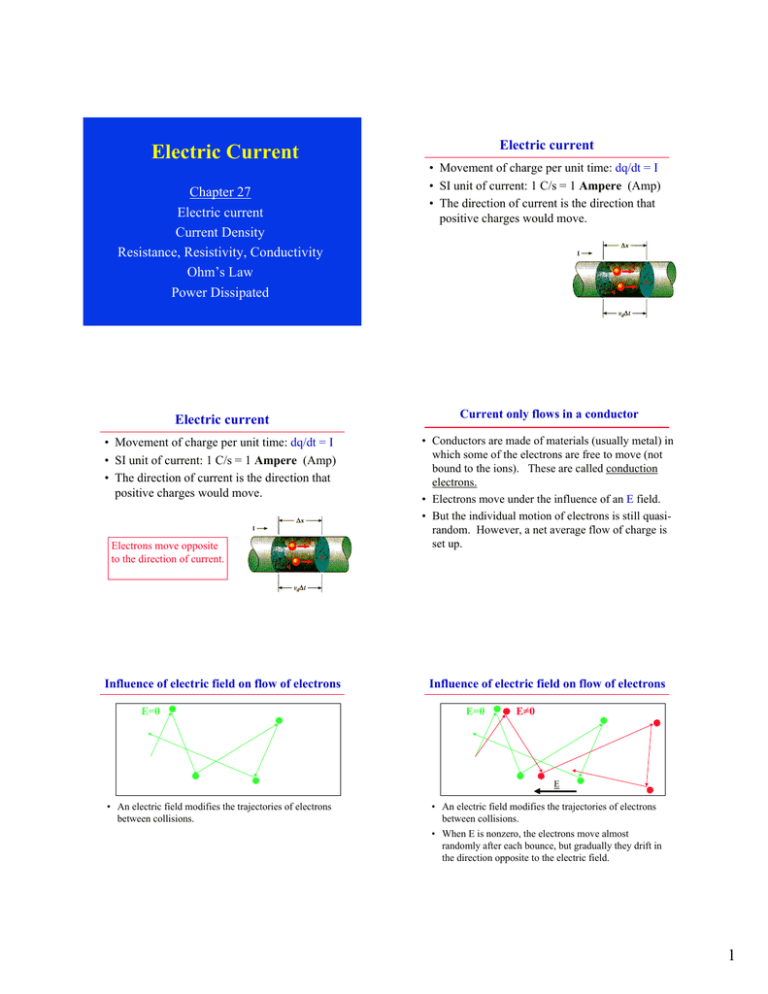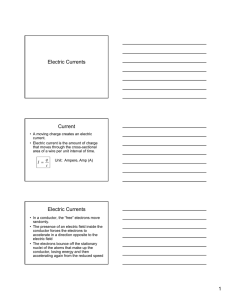in PDF format
advertisement

Electric current Electric Current Chapter 27 Electric current Current Density Resistance, Resistivity, Conductivity Ohm’s Law Power Dissipated • Movement of charge per unit time: dq/dt = I • SI unit of current: 1 C/s = 1 Ampere (Amp) • The direction of current is the direction that positive charges would move. Electric current Current only flows in a conductor • Movement of charge per unit time: dq/dt = I • SI unit of current: 1 C/s = 1 Ampere (Amp) • The direction of current is the direction that positive charges would move. • Conductors are made of materials (usually metal) in which some of the electrons are free to move (not bound to the ions). These are called conduction electrons. • Electrons move under the influence of an E field. • But the individual motion of electrons is still quasirandom. However, a net average flow of charge is set up. Electrons move opposite to the direction of current. Influence of electric field on flow of electrons E=0 Influence of electric field on flow of electrons E=0 E=0 E • An electric field modifies the trajectories of electrons between collisions. • An electric field modifies the trajectories of electrons between collisions. • When E is nonzero, the electrons move almost randomly after each bounce, but gradually they drift in the direction opposite to the electric field. 1 Current density Current density • The current density J is defined as the current I flowing per unit area. • That is, if current I flows through a surface A: J = I/A • After an electron collides with an ion, it will accelerate under an E field with a = eE/m. • Suppose the average time between collisions is τ. • Then the average velocity is vd = aτ = eEτ / m. • This velocity is called the electron drift velocity A Density of electrons: n vd Number of electrons: N=n(Avd∆t) vd∆t • Construct the above volume. In time ∆t all the electrons in it move out through the right end. • Hence the charge per time (the current) is I = (Ne)/∆t = neAvd. • The current density is J = I/A = nevd = (ne2τ/m)E. Example: What is the drift velocity of electrons in a Example: What is the drift velocity of electrons in a Cu wire 1.8 mm in diameter carrying a current of 1.3 A? Cu wire 1.8 mm in diameter carrying a current of 1.3 A? In Cu there is about one conduction electron per atom. −3 28 The density of Cu atoms is n = 8 .49 x10 m Find vd from J=I/A=1.3A/(π(0.0009m)2)=5.1x105 A/m2 Now use vd = J . ⋅105 A / m2 51 = 28 ne ( 849 . ⋅10 / m3 )(16 . x10−19 C ) v d = 3.8 ×10 −5 m s - Much less than one millimeter per second! Ohm’s Law •The current density, J, is proportional to the applied field, E, (both are vectors) or: • • J=σE - “Ohm’s Law” • σ is the “Conductivity”, J/E. • Units are (A/m2) divided by (V/m) = A/(Vm) • We define the “Resistivity” as ρ = 1/σ = E/J • Units of ρ are (V/A)m (= Ω - m). Ohm’s Law σ and ρ are dependent only on the material, - not its length or area. Consider a metal rod, resistivity ρ: +V ρ, area A 0 volts L E= ρJ (V/L) = ρ (Ι/Α) V = (Lρ ρ/A) I V=IR 2 Ohm’s Law Example: • V = I R - the most commonly used form of Ohm’s Law. What is the resistance of an 0.5 m length of 22 gauge steel wire? • R is the “Resistance”, that depends on the material type and shape: • R = ρ L/A Units: ohms, (Ω). • As ρ=RA/L, common units for resistivity are Ohm-meters. • Similarly, common units for σ are (Ohm m)-1 Example: Electrical Power Dissipation What is the resistance of an 0.5 m length of 22 gauge steel wire? Note: 22-gauge has a radius of 0.321 mm • In travelling from a to b , energy decrease of dq is: dU = dq Vab R = ρ L/A A = πr2 πr2) R = ρ L/(π ρ = 10−8 Ω-m π (0.000321 m)2) R = 10−8 Ω-m 0.5 m /(π = 0.015 Ω • • • • a dq b Resistance, R Now, dq = I dt Therefore, dU = I dt Vab Rate of energy dissipation is dU / dt This is the dissipated power, P. (Watts, or Joules /sec) • Hence, L Vab P = I Vab or: 2r Example A heating coil of a hot water heater has a resistance of 20 Ω and operates at 220 V. A. How much current does this heater draw? B. At what rate is power consumed? C. How much energy is consumed in 15 mins? • P = I2 R = V2 / R Example A heating coil of a hot water heater has a resistance of 20 Ω and operates at 220 V. A. How much current does this heater draw? I = V/R = 220 V/20 Ω = 11 Amps B. At what rate is power consumed? P = IV = 11 A 220 V = 2420 Watts, or P = V2/R = (220 V)2/20 Ω = 2420 Watts, or P = I2R = (11 A)2 20 Ω = 2420 Watts C. How much energy is consumed in 15 mins? dU = I dt V or U = IV ∆t = P ∆t U = 2420 W (15 min 60 sec/min) = 2178 kJ 3



